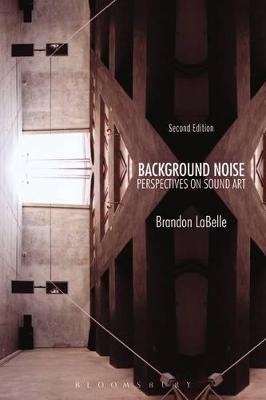
Background Noise, Second Edition
Bloomsbury Academic USA (Verlag)
978-1-62892-352-0 (ISBN)
At its center the book presupposes an intrinsic relation between sound and its location, galvanizing acoustics, sound phenomena, and the environmental with the tensions inherent in what LaBelle identifies as sound's relational dynamic. For the author, this is embedded within sound's tendency to become public expressed in its ability to travel distances, foster cultural expression, and define spaces while being radically flexible.
This second expanded edition includes a new chapter on the non-human and subnatural tendencies in sound art, revisions to the text as well as a new preface by the author. Intersecting material analysis with theoretical frameworks spanning art and architectural theory, performance studies and media theory, Background Noise makes the case that sound and sound art are central to understandings of contemporary culture.
Brandon LaBelle is an artist and writer working with sound culture and locational identities. His previous book, Background Noise: Perspectives on Sound Art, was published in 2006 by Bloomsbury Academic. He is the editor of Errant Bodies Press and organizer of the related Surface Tension project. He is currently Professor at the National Academy of the Arts in Bergen, Norway.
Acknowledgements
Preface to the Second Edition
Introduction: Auditory Relations
Fade In
Part 1: 4'33": Sound and Points of Origin
Introduction to Part 1
Chapter 1 Sociality of Sound: John Cage and Musical Concepts
Chapter 2 Exposing the Sound Object:Musique Concrète's Sonic Research
Chapter 3 Automatic Music: Group Ongaku's Performative Labors
Part 2: Box with the Sound of Its Own Making: From Gags to Sculptural Form
Introduction to Part 2
Chapter 4 Rhythms of Chaos: Happenings, Environments, and Fluxus
Chapter 5 Minimalist Treatments: La Monte Young and Robert Morris
Chapter 6 Conceptualizations:Michael Asher and the Subject of Space
Part 3: I Am Sitting in a Room: Vocal Intensities
Introduction to Part 3
Chapter 7 Performing Desire/ Performing Fear: Vito Acconci and the Power Plays of Voice
Chapter 8 Finding Oneself: Alvin Lucier and the Phenomenal Voice
Chapter 9 Word of Mouth: Christof Migone's Little Manias
Part 4: Public Supply: Buildings, Constructions, and Locational Listening
Introduction to Part 4
Chapter 10 Tuning Space:Max Neuhaus and Site-Specific Sound
Chapter 11 Other Architectures:Michael Brewster, Maryanne Amacher, and Bernhard Leitner
Chapter 12 Composing Intensities: Iannis Xenakis's Multimedia Architectures
Part 5: Soundmarks: Environments and Aural Geography
Introduction to Part 5
Chapter 13 Seeking Ursound: Hildegard Westerkamp, Steve Peters, and the Soundscape
Chapter 14 Language Games: Yasunao Tone and the Mechanics of Information
Chapter 15 Complicating Place: Bill Fontana and Networking the Soundscape
Part 6: Global Strings: Interpersonal and Network Space
Introduction to Part 6
Chapter 16 Interactions: Achim Wollscheid's Production of the Local
Chapter 17 Global Events: Atau Tanaka and Network as Instrument
Chapter 18 Live Streams: Apo33 and Multiplying Place
Fade Out
Conclusion: Auditive Pivot
Appendix: Peripheries – subnature, phantom memory, and dirty listening
List of Works Cited
Index
| Erscheint lt. Verlag | 26.3.2015 |
|---|---|
| Zusatzinfo | 30 bw images |
| Verlagsort | New York |
| Sprache | englisch |
| Maße | 152 x 229 mm |
| Gewicht | 564 g |
| Themenwelt | Kunst / Musik / Theater ► Musik ► Musiktheorie / Musiklehre |
| ISBN-10 | 1-62892-352-0 / 1628923520 |
| ISBN-13 | 978-1-62892-352-0 / 9781628923520 |
| Zustand | Neuware |
| Informationen gemäß Produktsicherheitsverordnung (GPSR) | |
| Haben Sie eine Frage zum Produkt? |
aus dem Bereich


